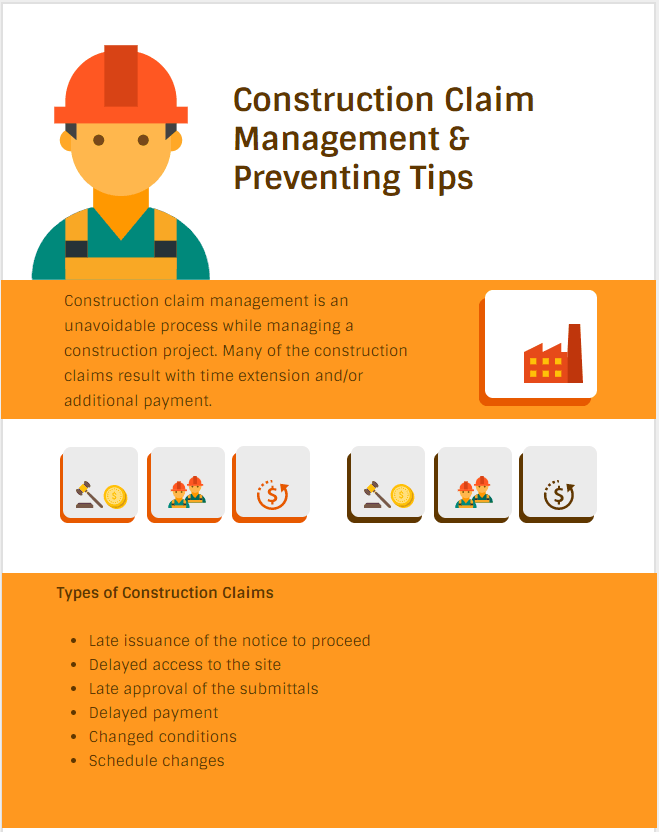What is the Construction Claim Management Process Roadmap? The construction world is crazy when it comes the potential for unforeseen circumstances. This can lead to what many dread of construction claims. These claims are often involving requests for time extension or additional payment. And they can arise from a variety of factors. Contractors might submit claims due to unforeseen costs related to overtime, increased overhead, delays or even situations that lead to lower efficiency.
Table of Contents
contract claim and delay management in construction works
The good news? Construction claim management is a powerful tool to solve these issues. In this way, you will understand the root causes of claims and take proactive steps to prevent them. Hence, you can significantly reduce their occurrence.
Thankfully, construction claim management and empowers you to navigate these situations.
Construction Claims & Prevention and Resolution Tips – projectcubicle
We’ll also dissect the essential steps of the construction claim management process:
The initiation process is simpler than it sounds. Think of it as the first step in an journey towards resolution.
The claim initiation is your ticket to getting the compensation you deserve. Without it, you would be left singing a sad tune. When you initiate a claim promptly, you set the wheels in motion.
Steps to Initiate a Claim
First, you should gather all relevant information. These can be receipts, photos and any other evidence that can support your claim. Then, contact your insurance provider or the responsible party. They will guide you through the necessary paperwork and procedures.
Staying on Top of the Process
After initiation, it is crucial to do a follow up. You should track all deadlines and ensure all documents are submitted. Also, you should maintain open communication with your provider. A little diligence goes a long way in speeding up the process.
Construction Claims and Responses
The number of construction claims has increased since the middle of the 1970s. Most of them were related to delay, schedule and performance issues. As a result of many construction cases (Chantilly, Pittman, etc.), court decisions provided a new point of view to both contractors and owners. Hence, this provides a common practice to the contractors for reserving their rights.
claim management in construction projects
Typically there are two main participants in a construction business. These are the owner and the contractor. The construction contract is signed between the parties provides rights to both of them. The owner’s right is to issue change orders under the terms of the contract. And the contractor’s right is to reserve his rights for delay and cost impacts.
The most of the claims are related to delay, acceleration, disruption and performance. So the issue of planning, scheduling and performance reporting became key issues.
Protect Your Project’s Profits:
- Early Warning Systems proactively identify potential issues before they escalate into costly claims.
- Claim Management Software streamlines data organization and analysis. Also, you can use other Claim Management Software!
- Quantification of Damages techniques like cost impact analysis present a clear financial picture.
- A proactive approach strengthens your negotiation position and allows for exploring alternative Dispute Resolution Methods.
Construction Claims Got You Stressed? Breathe Easy with Effective Claim Management
Effective claim management is your secret weapon to navigate those tricky situations. Because when you spot potential delays before they snowball into expensive claims, it will be way easier. Early Warning Systems can act like a smoke detector. And they will be alerting you to potential issues. With clear records within your Claim Management Software, you can minimize disputes and ensure any claims you have are backed by solid evidence. Such as photos, witness statements, etc.
The Construction Claim Management Process: A Roadmap to Resolution
Delays, disruptions, differing site conditions can all lead to claims for time extensions or additional payment. But with a good construction claim management process, you can easily handle similar issues.
Here’s a breakdown of the key steps in Construction Claim Management Process
-
Claim Initiation & Preparation: This is where you formally document the claim. A clear Notice of Claim is drafted. This will be outlining the specific claim type such as delay, disruption, etc Claim Documentation is crucial. Because it includes gathering evidences like schedules, photos, witness statements and any relevant contracts. Quantification of Damages is essential. When you are using techniques like cost impact analysis or schedule delay analysis, you can establish the financial impact of the claim.
-
Claim Negotiation & Resolution: This is where you work towards a settlement. Negotiation Strategies come into play, as you present your claim and supporting evidence to the other party. Depending on the situation, various Dispute Resolution Methods can be applied. Sch as mediation or arbitration. A thorough understanding of key Contract Clauses regarding changes, delays and termination procedures is necessary.
-
Claims Administration: This involves managing the claim throughout its lifecycle. Good record-keeping, clear communication and adherence to contractual deadlines are essential.
-
Early Warning Systems & Claim Prevention: Implementing Early Warning Systems allows you to identify potential issues before they escalate into full-blown claims. Claim Prevention Techniques focus on proactive measures like clear communication, risk management strategies and a collaborative project environment.
Construction Claims? Don’t Let Them Sink Your Project’s Profits
A solid claim management strategy can be your financial lifesaver. Because clear contract clauses outlining changes, delays and termination procedures. These set expectations upfront and avoid misunderstandings down the road. Throughout the project, you should not neglect your records such as schedules, photos, witness statements. Because these are your golden tickets when it comes to preparing claims.
construction claim management with Software
Claim Management Software (Claim Management Software) acts like your digital filing cabinet. Because it is keeping everything organized. Using cost impact analysis to quantify damages, you can clearly show the financial impact of any disruptions. With a good claim and contractual rights understanding, you can confidently manage negotiations and explore dispute resolution method.
Empower Your Team to Be Construction Claim Management Champions
Knowing the different types of claims (delays, disruptions, unexpected site conditions) helps them spot potential issues early. By setting up Early Warning Systems, they can proactively communicate problems and start preparing claims if needed. Claim Management Software simplifies data collection and analysis in this regard.
But effective claim management is more than just reacting to problems. With open communication, you can minimize misunderstandings and prevent claims from arising. Regular training on contract interpretation and industry best practices ensures your team is prepared for anything.
The Importance of Documentation and Timely Response in Construction Project Claim Management
Project documentation is very important to store the project information. Daily logs, photographs, cost reports, schedules, minutes of meetings, RFI’s (Request for Informations) and shop drawing logs are the all documents. Because they give the right answer to the question: What has happened ?
The contractor’s documents can differ from the owner’s. Because of their bias and interpretation of project problems can often be different from each other. Therefore documentation is the best way to prevent construction claims.
claim management in construction
Timely response is as important as documentation. A successful contractor notifies the owner in a written form when there is a change. It is also necessary when owner demands additional work.
Contractors often use RFI (Request for Information) as a communication tool to get information regarding the status. Typically, RFI’s include a question or comment section to be filled out by them and a response section to be filled out by the owner.
Reservation of right claims often arise from these RFI’s. Because contractors often create RFI’s to notify that their operations are stopped due to the incomplete plans. Or another reason can be specifications or they became unproductive because the owner’s engineers did not lead in a direction.
Types of Construction Claims
Contractors make claims against the owner to reserve their rights. And owners make claims against the contractors considering the contractor’s low performance.
Below are some of the typical construction claims that the contractors make these days.
- Late issuance of the notice to proceed
- Delayed access to the site
- Late approval of the submittals
- Delayed payment
- Changed conditions
- Schedule changes
- Delay in answer to field questions
- Changes in the method of construction
- Owner directed changes
Tips for Preventing Claims and Construction Project Claim Management
Before you kick off any project, you should get friendly with your contract documents. This legal agreement between you and the contractor covers everything from the scope of work to general and special conditions.
Know Your Delivery Method
Whether it’s design-build, design-bid-build, design-build-operate or turnkey, you should state your delivery method. Each method has its nuances. And knowing these can make a world of difference in managing your project seamlessly.
Organize Like a Pro
You should also set a chart and clearly map out responsibilities. Who’s handling the work schedule, contracts, payments, claims and approvals? Everyone should know their roles to prevent mix-ups and delays.
Get Specific with Specs
You should prepare technical specifications to detail your project’s needs and expectations from the contractor. This will help you to become on the same page.
Lock Down Those Dates
Also, you should clarify all milestone dates. Such as project start and finish, site handover and any constraints. Your work schedule specifications should be crystal clear about your project’s time performance.
Team Up with Subcontractors
You should include prime contractors with their subcontractors in the schedule preparation and execution.
Document Everything
And it is a good idea to create a library for all original and revised documents used during the design and bidding phases.
Regular Check-ins
And also, it is always good idea to schedule regular meetings with your team to discuss any construction changes and train them accordingly.
Construction Claims Management , Claims and Responses – projectcubicle
Conclusion
It is essential to manage claims by understanding the root causes. So, you can take actions such as for alignment of documents and keeping site records safe. Also, it is often cheaper to resolve the disputes between parties by mutual understanding.
It seems that most of the claims occur during the construction phase. In other words, once tender documents are completed and the contract is awarded, you can only avoid claims during the construction phase.
Effective construction claim management
Avoiding or minimizing claims is a proactive action in each phase. If the project documents are prepared with adequate information with open communication, it will be easy to avoid claims during the design and bidding phases.
See Also
Conflict Management Techniques
External References

Victor Z Young is a Civil Engineer with 35 years of experience working alongside the executive team of various construction companies. Victor specializes in construction insurance, delay analysis, performance analysis and engineering. He holds a Doctor of Project Management from Northwestern University.
















This article provides valuable insights into construction claim management. I appreciate the breakdown of the processes involved and the practical tips for minimizing disputes. Understanding these strategies is crucial for improving project outcomes. Looking forward to more informative content!